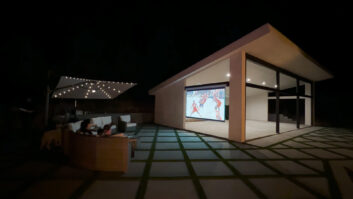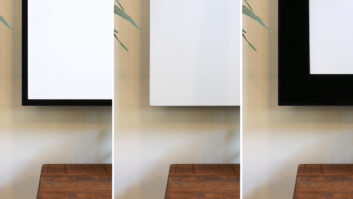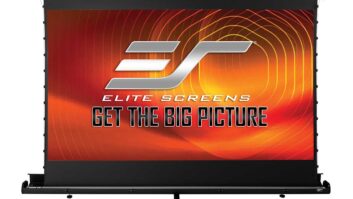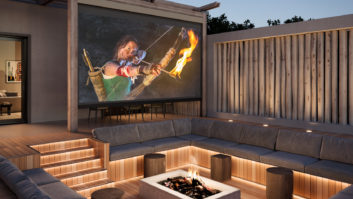Reflecting on what’s hot in the projection screen category for manufacturers is a little like casting their own footprints up on the wall. In opening themselves up like this, the top screen manufacturers have expressed both caution and opportunity for 3D screen technology, confirmation of the rise of multi-purpose media rooms, and a multitude of intriguing predictions for what types of changes this product class may go through.
Stewart clients remain a bit apprehensive about 3D screen technology. The Silver 5D screen material features improved polapolarization-preserving technology to reduce artifacts and allow a single screen material to function better with non-polarized 2D projected source material.
Trending in Multiple Dimensions
The biggest trend in projection screens is a direct reflection on increase in 3D content and projector technology. Not surprisingly, there are a range of views regarding the viability for 3D screens to dominate the market long term and the views of the different types of challenges that the technology presents.
“Stewart clients want to have 3D but are still a little afraid,” said Grant Stewart, president and CEO of Stewart Filmscreens. “It’s a complicated technology. As leaders in the screen industry, we have to train dealers on how to sell 3D.”
Integrators are faced with new challenges as a direct result of 3D installations. According to Spencer Mallinson, technical director for Vutec, some of the questions dealers frequently pose include the choice between active or passive; how to show 2D images on a 3D screen; whether masking screens are required for setup; and the benefits of a high gain screen with 3D.
“In many ways, we have entered new territory,” said Bob Hadsell, home theater sales manager for Draper, commenting on the fairly recent burst in residential 3D popularity. Draper’s dealers are not all jumping onboard too quickly though. “There is not much good content available, so many are still in a wait-and-see position. Those who are venturing into 3D have questions on which type of screen is best for 3D,” Hadsell said.


Elite Screens’ David Rodgers believes that despite 3D’s buzz in the projection screen market, there will always be a place for 2D content as well.
The technological challenges Draper sees manufacturers facing includes passive, polarized 3D. “Producing a product that maintains excellent polarization at a reasonable investment will be key in helping the technology evolve.”
But the ultimate challenge is to make the technology more attractive in the future. “The real desire is for 3D to be glasses free. We are several years away from having [that type of] workable front-projection technology available,” Hadsell said.
Manufacturers also caution consumers must understand that screens are not what create a 3D image by any means, and this issue gets into the highly technical nature of the technology. “Resellers, integrators, and manufacturers need to educate their consumers that 3D projection screens enhance the brightness, contrast, and color performance of 3D projectors but cannot turn a 2D projector’s image into a 3D presentation by themselves,” said David Rodgers, marketing manager for Elite Screens.
Ensuring that customers understand insertion loss is another challenge manufacturer’s face, according to Stewart. “Few people understand that you’re basically wearing sunglasses,” he said.
Rodgers does not believe that everything is going to be 3D in the future. “Caution needs to be exercised, and resellers and integrators need to remember that over-hyping the consumer’s need for 3D should not overshadow the continued demand for 2D images also,” he said.
Through the 2D Looking Glass
As other trends, Rodgers points to a few traditionally commercial applications that are creeping into the residential sector, including interactive and rear-projection screens. He noted that whiteboard-style screens are more durable and easier to clean, which “comes in handy with households that have small children.” Though not a widespread practice, he’s also seen the interactive screens used in residential applications where children are home schooled. In warmer regions, where outdoor AV applications are more common, “outdoor speakers and rigid ‘window-integrated’ rear projection video sources are growing in popularity,” Rodgers said.
Also in the projection screen world beyond 3D, some manufacturers noted the shifting focus away from dedicated home theater rooms. “The biggest trend we’re seeing is the family room once again becoming the entertainment center; with home theater, gaming and TV all combined in a single space,” said Jesse Walsh, U.S. sales and marketing manager for dnp. “The dedicated man cave theater room is rapidly becoming a thing of the past.”

The biggest challenge for projection screen manufacturers for Da-Lite is keeping up with new projection technologies. The Pico Screen he new Pico Screen is a lightweight, portable projection system for business meetings, training, gaming, and many other applications.
Ryan Gustafson, president and CEO of Screen Innovations (SI), confirmed the same trend. “Customers are installing projectors and screens into family rooms, game rooms, and living spaces versus theater rooms and man caves,” he said. “Due to the economic downturn, our customers are not building dedicated media rooms nearly as often. Most jobs are retrofit and require brighter projectors and ambient light screens.”
The recession has created other challenges for the industry to adapt to and overcome. “When the economy was good, there was a big market between custom install and retail. That line isn’t very clear anymore, because not as many people can sustain the costs that come with a custom install job,” Elite’s Rodgers said. “Lower cost versatility enables resellers to negotiate prices more aggressively without losing a significant profit margin. Making a desirable product that sells easy at a low price but is still profitable to resellers and integrators is a constant challenge.”
According to Gustafson, “the average Joe” does not want the hassle of buying a front-projection system and will settle for simply buying a 72-inch flat panel. “If projection is to succeed for the masses, the selling process must be simplified by creating bundled pricing that includes installation–consumers want an easy sales process and turn-key solutions,” he said.
And future-proofing a system is another key to selling to the price-conscious, Stewart pointed out. “People don’t want to spend on a screen if they think it’s going to be obsolete,” he said.
A continued trend in the market is for bigger and better screens for a larger experience overall, as Michael Liesenfeld, president of IMAGE Screens noted. “Additionally, stealth or invisible screens seem to be hitting the mark with consumers who also want high performance, so we at IMAGE Screens see a significant upward trend with our curved IMAGE Screens iMasque and IMAGE Screens artMasque in-wall screen solutions.”

Since 3D activity in the residential market burst into the scene in the last 12 to 18 months, Draper’s Bob Hadsell believes that in many ways, the industry is in uncharted territory. The TheatreMask is available in both width and height masking systems.
And there’s always the ever-important issue of well-trained, experienced personnel. “Our industry needs to pay better to get better-trained people capable of handling complex technical aspects of the system to bring it to next level,” Liesenfeld said. “Good people leave the industry to make more money elsewhere. Certainly hobbyists do not help to make this business a more professional one.”
For Da-Lite, “The biggest challenge for a projection screen manufacturer is to stay in stride with new projection technologies,” said Wendy Long, vice president of marketing. “Da-Lite has six chemists on staff that are dedicated to continually developing superior projection screen surfaces to match current and future projection screen technologies.”
Gazing into the Crystal Ball
In eyeing future growth opportunities, screen manufacturers offered a range of theories about the future.
“I believe 3D projectors will continue to evolve and improve,” Long said. “I also believe LED projection technology is going to continue to improve and become more popular.”
IMAGE’s Liesenfeld agreed that 3D will continue to improve, as well as virtual applications. “I see applications from several science fiction movies going into much wider markets–not in 2012, but by 2015 we’ll have lots of them in places you would not expect them. No static display will be able to create these types of images.”
Vutec also predicted a more sci-fi like trend to take off, “3D holographic images for movies games and sports,” Mallinson said, in addition to glasses-free 3D eventually.
Elite Screen’s Rodgers sees screens with enhanced acoustic performance in addition to 3D as the top trends. For the future, he said “I could see the marriage of the two, a material that lets sound breathe through it pretty easy and is also going to enhance your color quality.”
The next big product release for Elite is an acoustically transparent material that was recently certified by THX, which has yet to be officially announced. The material features higher gain properties for use with 3D and low-lumens projectors.
And further off in the future, Rodgers, having seen early prototypes, predicts, “Eventually, the home theater projection screen will likely be replaced by a form of pliable LCD material, but that is still decades from now before a product such as that could be affordable to the average home.”

Many dealers ask Vutec how they can show 2D images on a 3D screen. The SilverStar 2D/3D-A is made for both content types.
For SI’s Gustafson, the advancing projection screens’ shift into the home is about staying ahead with product innovation. “Like flat panels, future screen technology must allow any projector to work in any environment any time. New screen technologies need to offer amazing contrast and a bundled price point that competes with today’s flat panels,” he said.
Stewart’s prediction is that with more pixels and content hitting the screen, screens will evolve to capture and reflect it properly. “What that will do will lead to a different type of screen,” he said.
“What will happen also is to make [the experience] more immersive; the shapes of the screens will change,” Stewart also predicted.
The ultimate optimistic outlook came from dnp’s Walsh, who believes projection systems will continue to grow in popularity, “and as costs come down, they will become more prevalent.”
Lindsey Snyder is assistant editor of Residential Systems and Systems Contractor News.







